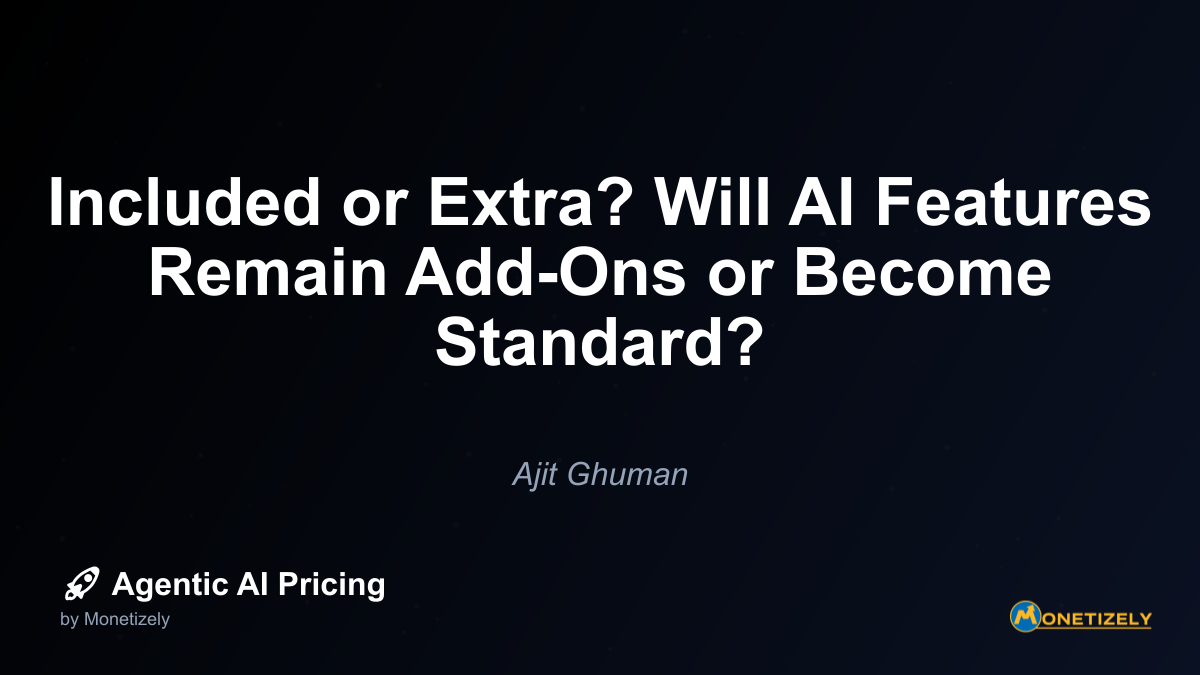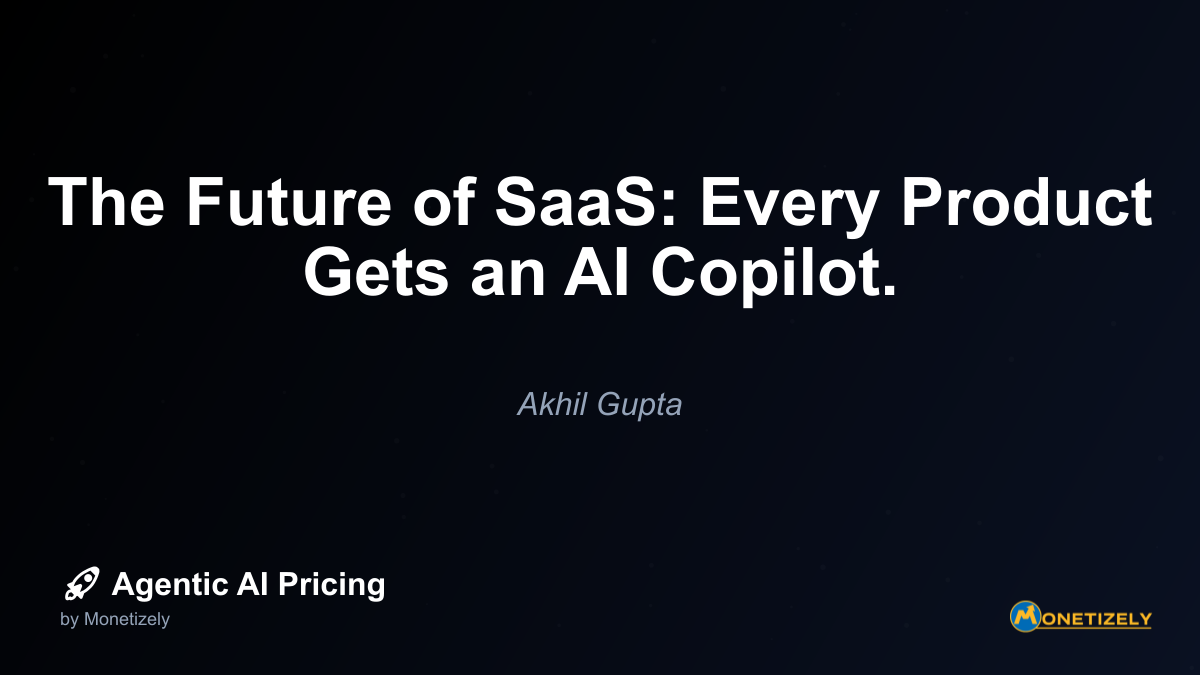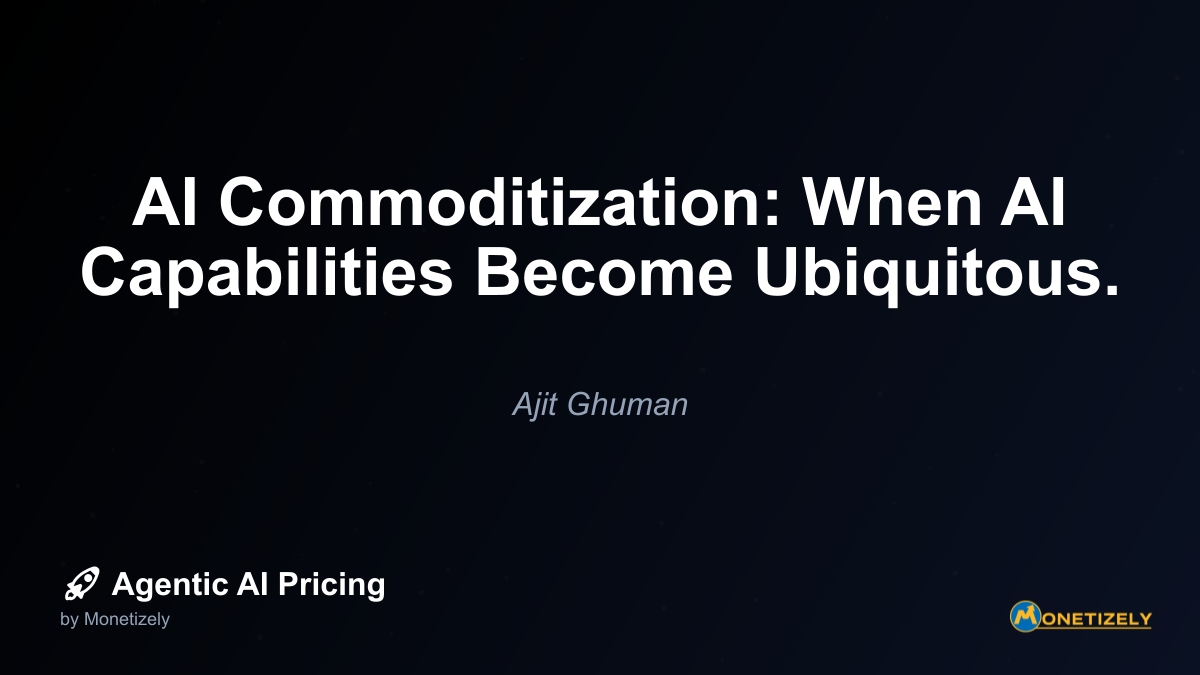· Ajit Ghuman · Emerging Trends · 10 min read
Included or Extra? Will AI Features Remain Add-Ons or Become Standard?
AI and SaaS Pricing Masterclass
Learn the art of strategic pricing directly from industry experts. Our comprehensive course provides frameworks and methodologies for optimizing your pricing strategy in the evolving AI landscape. Earn a professional certification that can be imported directly to your LinkedIn profile.

The Premium Add-On Approach
Many vendors currently position AI capabilities as premium features deserving separate monetization. This approach is particularly prevalent among established SaaS platforms that have introduced AI capabilities to enhance existing product suites. Examples include:
- Tiered AI Access: Companies offering basic, advanced, and enterprise AI tiers with increasing capabilities and usage limits
- Feature-Specific Charges: Separate pricing for specific AI functions like document analysis, sentiment analysis, or predictive forecasting
- AI Credits System: Allocation of “AI credits” that customers consume when utilizing AI features, with options to purchase additional credits
This premium approach allows companies to recoup the substantial development and operational costs associated with AI technologies while creating new revenue streams. It also provides clearer ROI measurement, as customers can directly associate specific AI features with their corresponding costs.
The Bundled Standard Feature Approach
Conversely, some forward-thinking companies are integrating AI capabilities into their core offerings without explicit additional charges. This approach treats AI as fundamental infrastructure rather than a premium add-on. Examples include:
- AI-Native Platforms: New entrants building products with AI at the core rather than as an enhancement
- Competitive Differentiators: Companies using bundled AI to gain market share against competitors still charging separately
- Value-Based Pricing: Raising overall product pricing to reflect enhanced value, without specifically itemizing AI features
This bundling strategy can accelerate adoption, create switching costs, and position vendors as innovative market leaders. It also simplifies the customer experience by eliminating complex pricing decisions around AI features.
Market Signals: Where Are We Heading?
Several key market signals provide insights into the likely evolution of AI pricing models:
Signal 1: Commoditization of Basic AI Capabilities
As foundational AI technologies become more accessible through APIs, open-source models, and developer tools, basic AI capabilities are rapidly commoditizing. This trend suggests that elementary AI features—like simple classification, recommendation systems, and basic natural language processing—will likely become standard inclusions rather than premium differentiators.
“The democratization of AI development tools has significantly lowered barriers to implementation,” notes a recent industry analysis. “When everyone can easily implement a feature, charging a premium for it becomes increasingly difficult to justify.”
Signal 2: Emergence of AI-Native Competitors
New market entrants are building products with AI as their foundational architecture rather than as an add-on feature. These AI-native competitors often bundle sophisticated AI capabilities into their base pricing, forcing established players to reconsider their premium add-on strategies.
For example, emerging email marketing platforms now include AI-driven content optimization as standard, while established players still charge premium fees for similar capabilities. This competitive pressure accelerates the transition from premium to standard for many AI features.
Signal 3: Evolving Customer Expectations
Customer expectations regarding AI are rapidly evolving. What seemed magical and premium-worthy just 12-18 months ago is increasingly viewed as basic functionality today. This expectation shift creates market pressure to include more AI capabilities in standard offerings.
A recent survey found that 67% of business software buyers now expect basic AI assistance features to be included in base pricing, compared to just 34% two years ago. This represents a significant shift in perceived value and pricing expectations.
Signal 4: Operational Cost Trajectories
The operational costs of delivering AI capabilities—particularly those dependent on large language models—remain significant but are following a downward trajectory. As these costs decrease through technological improvements and economies of scale, the economic justification for separate AI pricing diminishes.
The Differentiation Imperative: Basic vs. Advanced AI
A crucial distinction is emerging between basic and advanced AI capabilities:
Basic AI Features Trending Toward Inclusion
Features that are becoming standard inclusions typically share these characteristics:
- Widely available technology: Capabilities built on accessible, commoditized AI models
- Lower computational requirements: Features with manageable inference costs
- Established use cases: Well-understood implementations with clear value propositions
- User expectation alignment: Features users increasingly expect as standard
Examples include basic document categorization, simple chatbots, elementary data visualization suggestions, and standard text completion.
Advanced AI Features Maintaining Premium Status
Capabilities likely to remain premium add-ons share these traits:
- Cutting-edge technology: Features utilizing the latest AI research and models
- Higher computational demands: Functions requiring significant processing resources
- Specialized expertise: Capabilities requiring domain-specific knowledge or training
- Quantifiable ROI: Features delivering measurable business outcomes
Examples include advanced predictive analytics, sophisticated agent-based automation, custom-trained models, and domain-specific expert systems.
Strategic Considerations for Vendors
For companies navigating this evolving landscape, several strategic considerations should inform AI pricing decisions:
1. Value-Based Assessment
The fundamental question should be: “Does this AI feature deliver sufficient unique value to justify separate monetization?” This requires honest evaluation of whether a capability truly provides distinctive value or is becoming an expected standard feature.
Companies should regularly reassess this question as market conditions evolve. What justifies premium pricing today may become a standard expectation tomorrow.
2. Competitive Positioning
Vendors must carefully consider how their AI pricing approach positions them against competitors. Premium add-on strategies may maximize short-term revenue but risk market share loss to competitors offering similar capabilities as standard features.
Conversely, bundling advanced AI capabilities into standard pricing may sacrifice immediate revenue potential but create competitive advantages through higher adoption rates and increased customer loyalty.
3. Cost Structure Alignment
AI features often involve different cost structures than traditional software functionality. While traditional features typically have high development costs but minimal ongoing operational expenses, AI capabilities frequently incur significant ongoing costs for model training, inference processing, and continuous improvement.
Pricing models should align with these underlying cost structures. Usage-based pricing components may be appropriate for computationally intensive AI features, even within otherwise subscription-based products.
4. Customer Segmentation Opportunities
Different customer segments have varying willingness to pay for AI capabilities. This creates opportunities for segmentation strategies that offer basic AI features as standard while positioning advanced capabilities as premium add-ons for segments with higher willingness to pay.
Effective segmentation in AI pricing can optimize revenue while expanding market reach across different customer profiles.
5. Adoption and Usage Incentives
Pricing strategies should consider how they influence adoption and usage patterns. Premium add-on pricing may create barriers to adoption, while bundled pricing removes financial friction but may result in underutilization if customers don’t recognize the value.
Some companies are employing hybrid approaches, such as including AI features in standard pricing but with usage caps or tiered performance levels. This encourages initial adoption while creating upsell opportunities for power users.
Industry-Specific Patterns and Predictions
Different sectors are displaying distinct patterns in their approach to AI feature pricing:
Enterprise Software
Enterprise software vendors typically maintain premium pricing for AI capabilities, often through specialized modules or higher-tier packages. This approach aligns with enterprise buyers’ procurement processes and willingness to pay for demonstrable business value.
However, competitive pressures are increasing, with some vendors beginning to include basic AI capabilities in standard offerings while maintaining premium pricing for advanced features. The enterprise market is likely to maintain a hybrid approach longer than other sectors.
SMB-Focused Solutions
Products targeting small and medium businesses face more immediate pressure to include AI as standard. This market segment is typically more price-sensitive and less willing to pay for separate AI add-ons unless they deliver obvious, immediate value.
Many SMB-focused vendors are already bundling AI capabilities into their core offerings, using enhanced functionality to justify overall price increases rather than separate line items.
Consumer Applications
In consumer applications, AI features are rapidly transitioning from premium differentiators to expected standard features. This market demonstrates the fastest commoditization cycle, with users quickly adjusting their expectations to include AI capabilities in base functionality.
Consumer-facing companies that maintain separate charges for AI features risk competitive disadvantage unless those features deliver exceptional, unique value beyond what competitors offer as standard.
The Transition Timeline: From Premium to Standard
Historical patterns in technology adoption suggest a predictable transition timeline for new capabilities:
- Innovation Phase: New AI capabilities emerge as highly differentiated, premium-priced features
- Expansion Phase: Early adoption drives wider awareness and implementation across the market
- Standardization Phase: Features become expected components of standard offerings
- Commoditization Phase: Features are universally available and no longer support premium pricing
This cycle is accelerating for AI features compared to previous technological innovations. Capabilities that might have maintained premium status for 3-5 years in earlier technology cycles may transition to standard expectations within 18-24 months in the current environment.
Strategic Recommendations for Forward-Thinking Companies
Based on emerging trends and market signals, forward-thinking companies should consider these strategic approaches:
1. Develop a Transition Roadmap
Rather than making binary decisions about AI pricing, develop a transition roadmap that anticipates the evolution from premium to standard for different capabilities. This roadmap should include trigger points based on competitive moves, cost trajectories, and customer expectation shifts.
2. Layer AI Capabilities Strategically
Create a strategic layering of AI capabilities, with basic features included in standard offerings while maintaining premium pricing for advanced capabilities. Regularly reassess this stratification as the market evolves.
3. Focus Innovation on Premium-Worthy AI
Direct AI innovation efforts toward capabilities that will maintain premium status longer—those delivering exceptional, measurable value that competitors cannot easily replicate. This approach creates a sustainable premium tier even as basic capabilities become standardized.
4. Consider Bundling Economics
Evaluate the economics of bundling AI features into standard pricing. While this may reduce direct AI-attributed revenue, it can drive higher overall product adoption, reduce sales friction, and increase total customer lifetime value through improved retention.
5. Create Value-Based Narratives
Develop clear value narratives for both included and premium AI capabilities. Help customers understand the business outcomes enabled by each feature rather than focusing on the underlying technology. This value-based framing supports price integrity regardless of whether features are bundled or separate.
Case Study: The Evolution of AI in CRM Platforms
Customer Relationship Management (CRM) platforms provide an instructive example of the evolving approach to AI feature pricing:
Phase 1: Premium AI Add-Ons (2017-2020)
When major CRM vendors first introduced AI capabilities, they positioned them as premium add-ons with separate pricing. These early AI features, such as predictive lead scoring and opportunity insights, commanded significant price premiums, often increasing per-user costs by 30-50%.
Phase 2: Tiered AI Inclusion (2020-2023)
As competition increased and AI capabilities matured, CRM vendors began including basic AI features in higher-tier packages while maintaining separate pricing for advanced capabilities. This hybrid approach balanced revenue optimization with competitive pressures.
Phase 3: Standard AI Features (2023-Present)
Currently, many basic AI capabilities are becoming standard inclusions across CRM pricing tiers. Vendors now differentiate on the sophistication and customization of AI rather than its mere presence. Premium pricing remains for advanced capabilities like custom prediction models and automated workflow generation.
This evolution demonstrates the typical transition pattern from premium to standard, with vendors continuously developing new premium capabilities while gradually including previously premium features in standard offerings.
Conclusion: The Inevitable Standardization Curve
The question of whether AI features will remain add-ons or become standard inclusions is not truly binary. Rather, we are witnessing an ongoing cycle of innovation, premium pricing, and eventual standardization—a cycle that will continue as AI technology evolves.
Basic AI capabilities are clearly trending toward standard inclusion across most software categories. This transition is happening faster than previous technology cycles due to rapid AI democratization, intense competition, and evolving customer expectations.
However, advanced AI capabilities will continue to command premium pricing, particularly those delivering measurable business outcomes, requiring significant computational resources, or leveraging proprietary data and models. The definition of “advanced” will continuously evolve as yesterday’s cutting-edge features become today’s standard expectations.
For vendors, the strategic imperative is not to fight this standardization curve but to navigate it intelligently—continuously developing new premium-worthy capabilities while gracefully transitioning maturing features into standard offerings. This approach maintains both competitive relevance and revenue optimization throughout the AI adoption cycle.
The companies that will thrive in this environment are those that can simultaneously deliver compelling standard AI capabilities while continuously innovating at the premium frontier. This balanced approach recognizes that the question is not whether AI features will become standard, but when and how to navigate that transition while maintaining business growth and competitive advantage.
In the end, the market will reward vendors who align their AI pricing strategies with genuine value creation rather than artificial feature segmentation. The future belongs to those who can continuously deliver AI innovations worthy of premium pricing while gracefully incorporating maturing capabilities into their standard offerings.
Co-Founder & CEO
Ajit is the author of Price To Scale, a top book on SaaS Pricing and is the Founder of Monetizely. Ajit has led and worked in pricing and product marketing at firms like Twilio, Narvar and Medallia. His work has been featured in Forbes and VentureBeat. Ajit regularly consults with software companies from Seed stage to post-IPO on pricing strategy. Ajit is also a highly-rated co-instructor for 'The Art of SaaS Pricing and Monetization' on Maven.
Pricing Strategy Audit
Let our experts analyze your current pricing strategy and identify opportunities for improvement. Our data-driven assessment will help you unlock untapped revenue potential and optimize your AI pricing approach.




